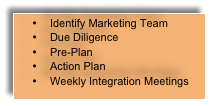Growth Insights for CEOs

AI Search is Here – And it’s Reshaping the Buyer Journey
Part 1 of our four-part series exploring how AI search is transforming visibility, SEO, and digital strategy - and what CEOs need to do now to stay competitive.
| Executive Takeaways |
| Declining web traffic isn’t random - it’s a symptom of changing search behavior. AI search is already impacting over 25% of user journeys - and growing fast If you’re not being cited, you’re missing opportunities-period. |
Recent Posts

Driving Marketing Post M&A
Tue, Jul 26, 2016 — M&A continues to be a preferred growth strategy for many executives according to KPMG’s 10th Annual Study of the M&A Outlook. The key trends driving M&A activity vary by industry sector but the primary challenge is consistent across the board - valuation disparity between the buyer and seller.[i] As a result, most of the effort is on financial evaluations during due diligence, and other areas, like human resources, can be postponed or overlooked.

Blending, the “Brady” Way: Six Steps to Post-Merger Harmony
Mon, Mar 28, 2016 — If you grew up in the same era as me, your mission-critical Friday night objective included tuning into “The Brady Bunch,” one of my favorite childhood television shows. Greg and Marsha Brady’s predicaments paled compared to the pickles my siblings and I often found ourselves in -- yet the Brady kids – forced into sibling union by the wedding of Mike and Carol, seemed to navigate American life of the 1960s and 70s with relative ease (despite losing Bobby and Cindy briefly on a Hawaiian island and surviving an ill-fated attempt to form a family band).

Closing the Small to Mid-Sized Company Merger – Is It Too Risky to Ink the Deal?
Thu, Mar 17, 2016 — In our previous post, we lit the fuse on the concept of how a merger or acquisition may be beneficial when swashbuckling one’s way through the uber-competitive marketing landscape of the present. By making it this far, you may have decided that this strategy may be prudent -- especially now that you know when and why you might consider M&A for your company. So let’s now take a look at the downside of such an initiative—the “glass-half-empty scenario.”
Stay up-to-date with the latest from Chief Outsiders

Building Company Value After an Acquisition
Sun, Mar 27, 2011 — Marketing’s Role in Post-Merger Integration The deal was just signed! Now what do we do? How many times have we heard this familiar cry? You are not alone. Over 70% of the deals completed today fail to add company value! The primary reason for most failures: poor post-merger integration planning and execution. The integration of two businesses after an acquisition is no longer restricted to the domain of Finance and IT. Markets drive our businesses today! The role of Marketing in building company value after an acquisition is more critical than ever before. To build market share, competitive dominance and product superiority, Marketing’s approach to the integration program must be very systematic. Marketing must uphold the brand, maintain customer confidence and leverage all possible synergies while vigilantly monitoring ROI. As if this isn’t a difficult enough balancing act, Marketing must articulate the longer-term “go-to-market” strategy to ensure the continuity of value enhancement programs long after the integration process is complete. So where do you begin?
.png?width=1500&height=398&name=CO_Corporate%20Logo%202021_4C_HOR_FNL-1%20(1).png)